Infectious Disease - HIV in India
VerifiedAdded on 2022/08/19
|10
|2380
|12
Assignment
AI Summary
Contribute Materials
Your contribution can guide someone’s learning journey. Share your
documents today.
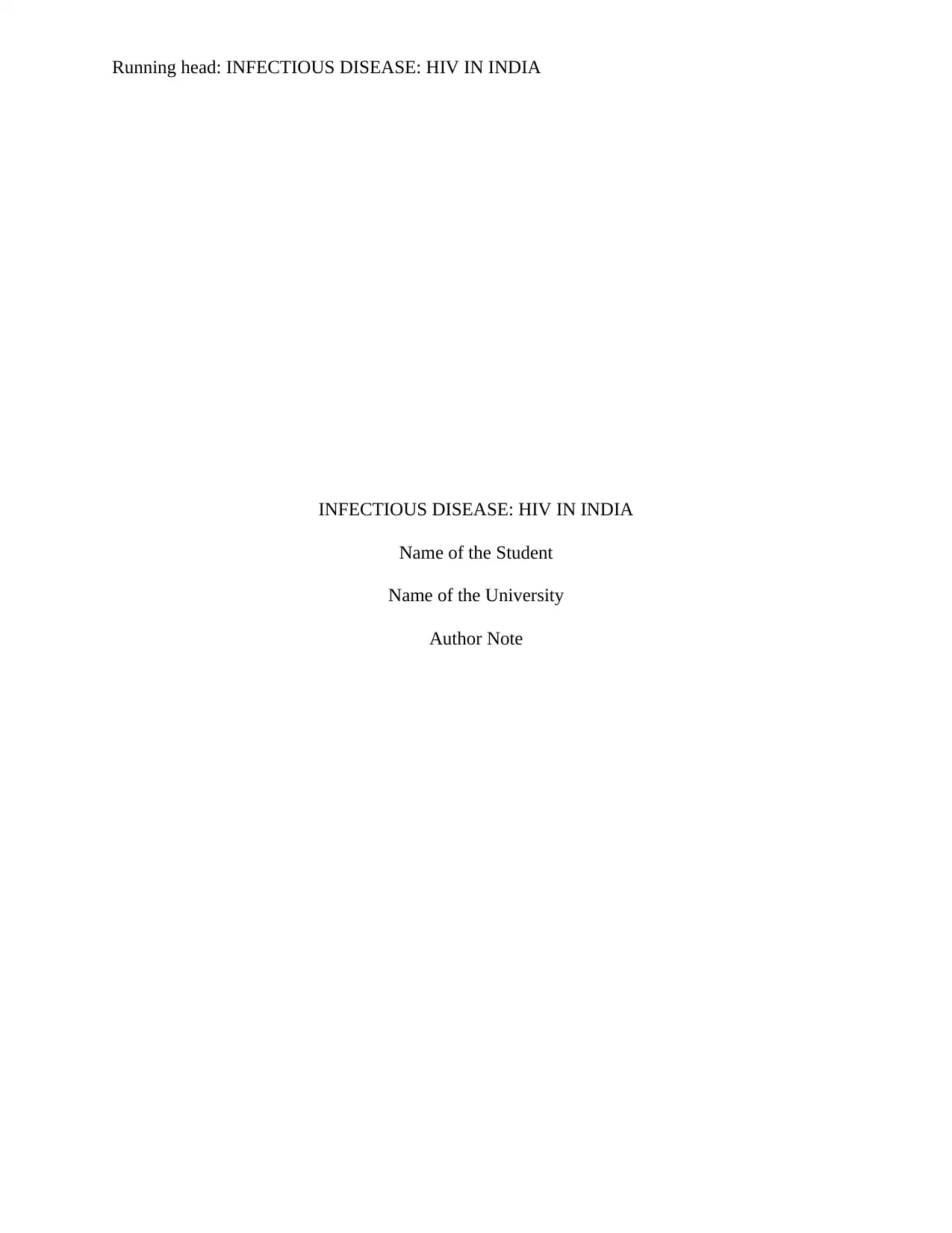
Running head: INFECTIOUS DISEASE: HIV IN INDIA
INFECTIOUS DISEASE: HIV IN INDIA
Name of the Student
Name of the University
Author Note
INFECTIOUS DISEASE: HIV IN INDIA
Name of the Student
Name of the University
Author Note
Secure Best Marks with AI Grader
Need help grading? Try our AI Grader for instant feedback on your assignments.
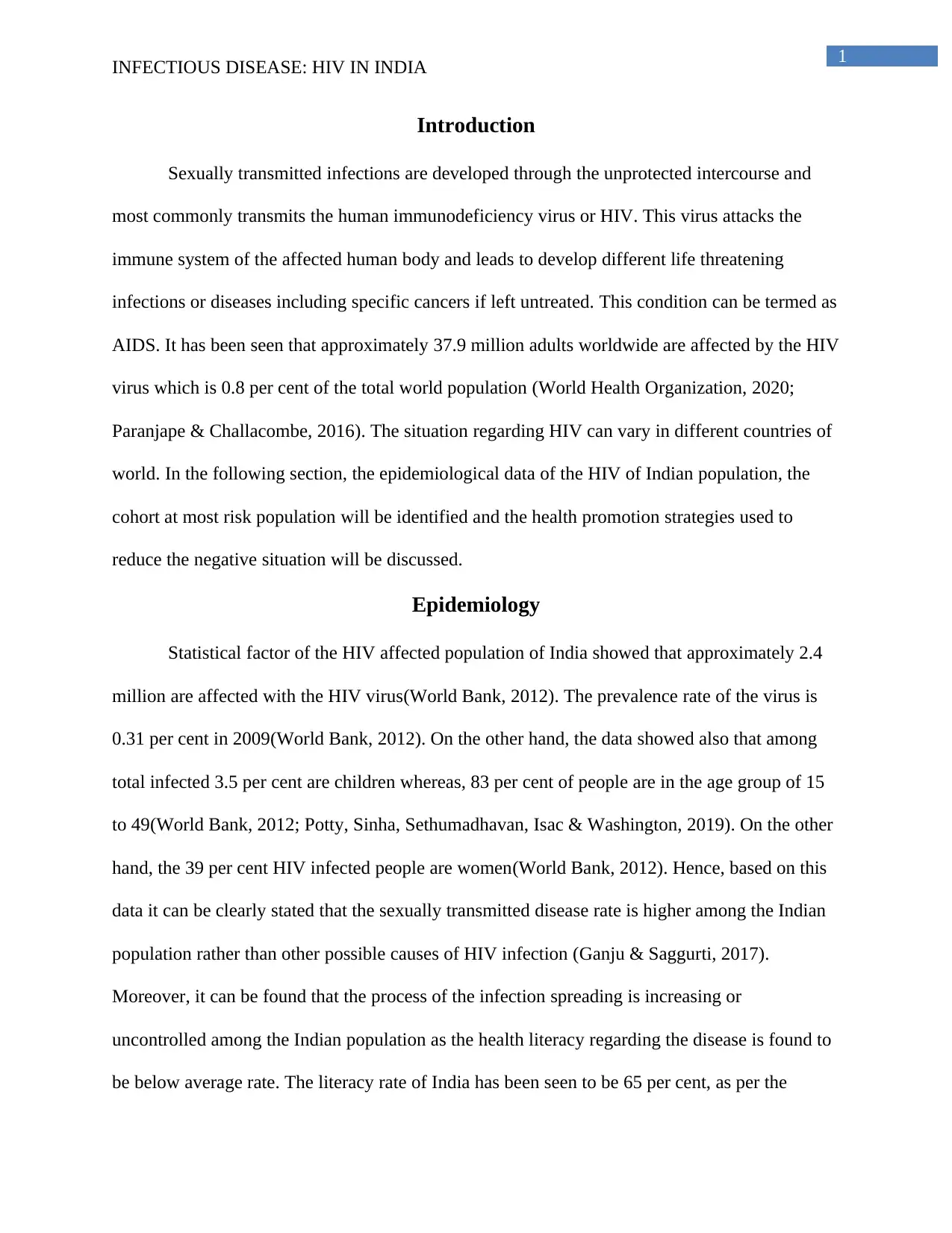
1
INFECTIOUS DISEASE: HIV IN INDIA
Introduction
Sexually transmitted infections are developed through the unprotected intercourse and
most commonly transmits the human immunodeficiency virus or HIV. This virus attacks the
immune system of the affected human body and leads to develop different life threatening
infections or diseases including specific cancers if left untreated. This condition can be termed as
AIDS. It has been seen that approximately 37.9 million adults worldwide are affected by the HIV
virus which is 0.8 per cent of the total world population (World Health Organization, 2020;
Paranjape & Challacombe, 2016). The situation regarding HIV can vary in different countries of
world. In the following section, the epidemiological data of the HIV of Indian population, the
cohort at most risk population will be identified and the health promotion strategies used to
reduce the negative situation will be discussed.
Epidemiology
Statistical factor of the HIV affected population of India showed that approximately 2.4
million are affected with the HIV virus(World Bank, 2012). The prevalence rate of the virus is
0.31 per cent in 2009(World Bank, 2012). On the other hand, the data showed also that among
total infected 3.5 per cent are children whereas, 83 per cent of people are in the age group of 15
to 49(World Bank, 2012; Potty, Sinha, Sethumadhavan, Isac & Washington, 2019). On the other
hand, the 39 per cent HIV infected people are women(World Bank, 2012). Hence, based on this
data it can be clearly stated that the sexually transmitted disease rate is higher among the Indian
population rather than other possible causes of HIV infection (Ganju & Saggurti, 2017).
Moreover, it can be found that the process of the infection spreading is increasing or
uncontrolled among the Indian population as the health literacy regarding the disease is found to
be below average rate. The literacy rate of India has been seen to be 65 per cent, as per the
INFECTIOUS DISEASE: HIV IN INDIA
Introduction
Sexually transmitted infections are developed through the unprotected intercourse and
most commonly transmits the human immunodeficiency virus or HIV. This virus attacks the
immune system of the affected human body and leads to develop different life threatening
infections or diseases including specific cancers if left untreated. This condition can be termed as
AIDS. It has been seen that approximately 37.9 million adults worldwide are affected by the HIV
virus which is 0.8 per cent of the total world population (World Health Organization, 2020;
Paranjape & Challacombe, 2016). The situation regarding HIV can vary in different countries of
world. In the following section, the epidemiological data of the HIV of Indian population, the
cohort at most risk population will be identified and the health promotion strategies used to
reduce the negative situation will be discussed.
Epidemiology
Statistical factor of the HIV affected population of India showed that approximately 2.4
million are affected with the HIV virus(World Bank, 2012). The prevalence rate of the virus is
0.31 per cent in 2009(World Bank, 2012). On the other hand, the data showed also that among
total infected 3.5 per cent are children whereas, 83 per cent of people are in the age group of 15
to 49(World Bank, 2012; Potty, Sinha, Sethumadhavan, Isac & Washington, 2019). On the other
hand, the 39 per cent HIV infected people are women(World Bank, 2012). Hence, based on this
data it can be clearly stated that the sexually transmitted disease rate is higher among the Indian
population rather than other possible causes of HIV infection (Ganju & Saggurti, 2017).
Moreover, it can be found that the process of the infection spreading is increasing or
uncontrolled among the Indian population as the health literacy regarding the disease is found to
be below average rate. The literacy rate of India has been seen to be 65 per cent, as per the
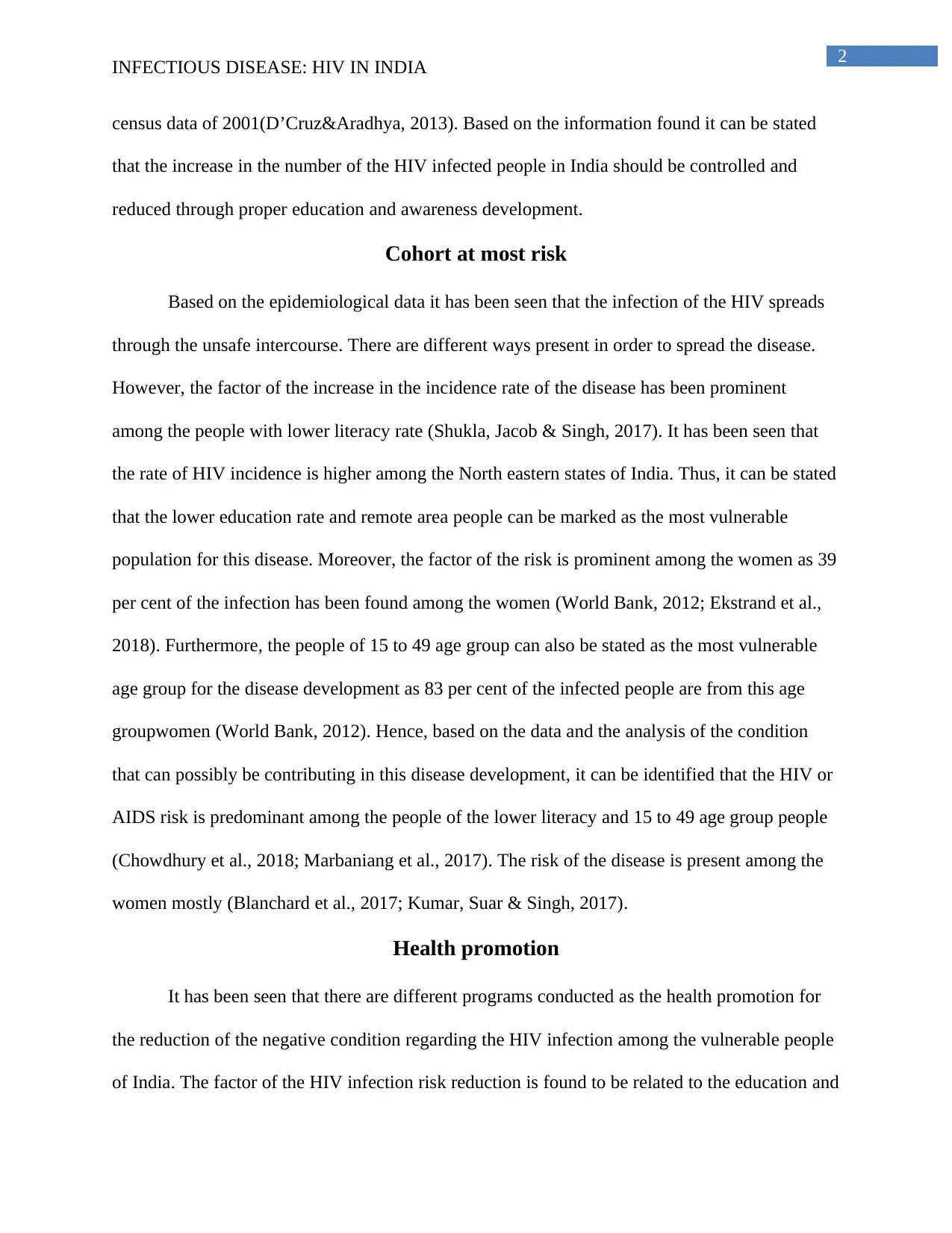
2
INFECTIOUS DISEASE: HIV IN INDIA
census data of 2001(D’Cruz&Aradhya, 2013). Based on the information found it can be stated
that the increase in the number of the HIV infected people in India should be controlled and
reduced through proper education and awareness development.
Cohort at most risk
Based on the epidemiological data it has been seen that the infection of the HIV spreads
through the unsafe intercourse. There are different ways present in order to spread the disease.
However, the factor of the increase in the incidence rate of the disease has been prominent
among the people with lower literacy rate (Shukla, Jacob & Singh, 2017). It has been seen that
the rate of HIV incidence is higher among the North eastern states of India. Thus, it can be stated
that the lower education rate and remote area people can be marked as the most vulnerable
population for this disease. Moreover, the factor of the risk is prominent among the women as 39
per cent of the infection has been found among the women (World Bank, 2012; Ekstrand et al.,
2018). Furthermore, the people of 15 to 49 age group can also be stated as the most vulnerable
age group for the disease development as 83 per cent of the infected people are from this age
groupwomen (World Bank, 2012). Hence, based on the data and the analysis of the condition
that can possibly be contributing in this disease development, it can be identified that the HIV or
AIDS risk is predominant among the people of the lower literacy and 15 to 49 age group people
(Chowdhury et al., 2018; Marbaniang et al., 2017). The risk of the disease is present among the
women mostly (Blanchard et al., 2017; Kumar, Suar & Singh, 2017).
Health promotion
It has been seen that there are different programs conducted as the health promotion for
the reduction of the negative condition regarding the HIV infection among the vulnerable people
of India. The factor of the HIV infection risk reduction is found to be related to the education and
INFECTIOUS DISEASE: HIV IN INDIA
census data of 2001(D’Cruz&Aradhya, 2013). Based on the information found it can be stated
that the increase in the number of the HIV infected people in India should be controlled and
reduced through proper education and awareness development.
Cohort at most risk
Based on the epidemiological data it has been seen that the infection of the HIV spreads
through the unsafe intercourse. There are different ways present in order to spread the disease.
However, the factor of the increase in the incidence rate of the disease has been prominent
among the people with lower literacy rate (Shukla, Jacob & Singh, 2017). It has been seen that
the rate of HIV incidence is higher among the North eastern states of India. Thus, it can be stated
that the lower education rate and remote area people can be marked as the most vulnerable
population for this disease. Moreover, the factor of the risk is prominent among the women as 39
per cent of the infection has been found among the women (World Bank, 2012; Ekstrand et al.,
2018). Furthermore, the people of 15 to 49 age group can also be stated as the most vulnerable
age group for the disease development as 83 per cent of the infected people are from this age
groupwomen (World Bank, 2012). Hence, based on the data and the analysis of the condition
that can possibly be contributing in this disease development, it can be identified that the HIV or
AIDS risk is predominant among the people of the lower literacy and 15 to 49 age group people
(Chowdhury et al., 2018; Marbaniang et al., 2017). The risk of the disease is present among the
women mostly (Blanchard et al., 2017; Kumar, Suar & Singh, 2017).
Health promotion
It has been seen that there are different programs conducted as the health promotion for
the reduction of the negative condition regarding the HIV infection among the vulnerable people
of India. The factor of the HIV infection risk reduction is found to be related to the education and
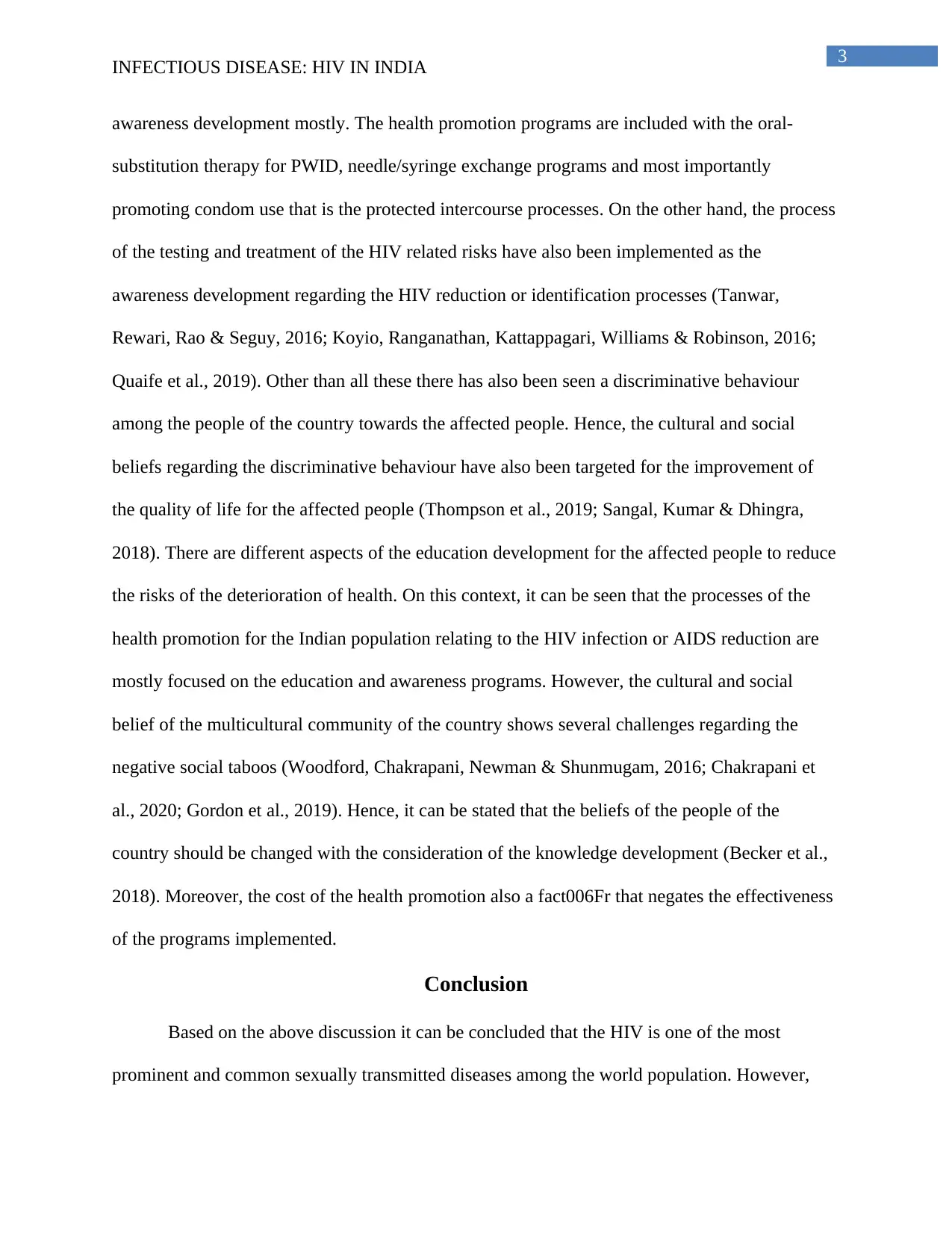
3
INFECTIOUS DISEASE: HIV IN INDIA
awareness development mostly. The health promotion programs are included with the oral-
substitution therapy for PWID, needle/syringe exchange programs and most importantly
promoting condom use that is the protected intercourse processes. On the other hand, the process
of the testing and treatment of the HIV related risks have also been implemented as the
awareness development regarding the HIV reduction or identification processes (Tanwar,
Rewari, Rao & Seguy, 2016; Koyio, Ranganathan, Kattappagari, Williams & Robinson, 2016;
Quaife et al., 2019). Other than all these there has also been seen a discriminative behaviour
among the people of the country towards the affected people. Hence, the cultural and social
beliefs regarding the discriminative behaviour have also been targeted for the improvement of
the quality of life for the affected people (Thompson et al., 2019; Sangal, Kumar & Dhingra,
2018). There are different aspects of the education development for the affected people to reduce
the risks of the deterioration of health. On this context, it can be seen that the processes of the
health promotion for the Indian population relating to the HIV infection or AIDS reduction are
mostly focused on the education and awareness programs. However, the cultural and social
belief of the multicultural community of the country shows several challenges regarding the
negative social taboos (Woodford, Chakrapani, Newman & Shunmugam, 2016; Chakrapani et
al., 2020; Gordon et al., 2019). Hence, it can be stated that the beliefs of the people of the
country should be changed with the consideration of the knowledge development (Becker et al.,
2018). Moreover, the cost of the health promotion also a fact006Fr that negates the effectiveness
of the programs implemented.
Conclusion
Based on the above discussion it can be concluded that the HIV is one of the most
prominent and common sexually transmitted diseases among the world population. However,
INFECTIOUS DISEASE: HIV IN INDIA
awareness development mostly. The health promotion programs are included with the oral-
substitution therapy for PWID, needle/syringe exchange programs and most importantly
promoting condom use that is the protected intercourse processes. On the other hand, the process
of the testing and treatment of the HIV related risks have also been implemented as the
awareness development regarding the HIV reduction or identification processes (Tanwar,
Rewari, Rao & Seguy, 2016; Koyio, Ranganathan, Kattappagari, Williams & Robinson, 2016;
Quaife et al., 2019). Other than all these there has also been seen a discriminative behaviour
among the people of the country towards the affected people. Hence, the cultural and social
beliefs regarding the discriminative behaviour have also been targeted for the improvement of
the quality of life for the affected people (Thompson et al., 2019; Sangal, Kumar & Dhingra,
2018). There are different aspects of the education development for the affected people to reduce
the risks of the deterioration of health. On this context, it can be seen that the processes of the
health promotion for the Indian population relating to the HIV infection or AIDS reduction are
mostly focused on the education and awareness programs. However, the cultural and social
belief of the multicultural community of the country shows several challenges regarding the
negative social taboos (Woodford, Chakrapani, Newman & Shunmugam, 2016; Chakrapani et
al., 2020; Gordon et al., 2019). Hence, it can be stated that the beliefs of the people of the
country should be changed with the consideration of the knowledge development (Becker et al.,
2018). Moreover, the cost of the health promotion also a fact006Fr that negates the effectiveness
of the programs implemented.
Conclusion
Based on the above discussion it can be concluded that the HIV is one of the most
prominent and common sexually transmitted diseases among the world population. However,
Secure Best Marks with AI Grader
Need help grading? Try our AI Grader for instant feedback on your assignments.
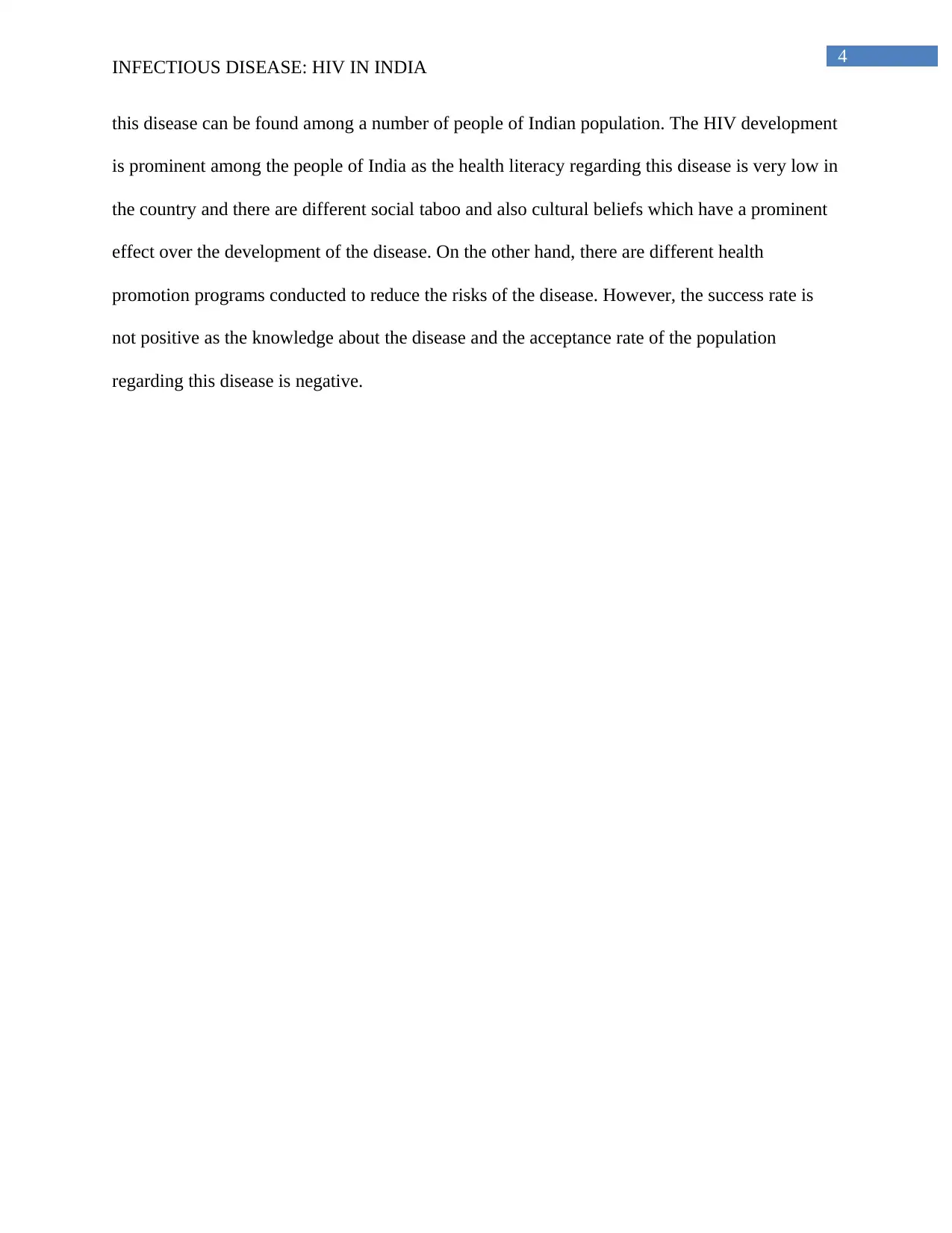
4
INFECTIOUS DISEASE: HIV IN INDIA
this disease can be found among a number of people of Indian population. The HIV development
is prominent among the people of India as the health literacy regarding this disease is very low in
the country and there are different social taboo and also cultural beliefs which have a prominent
effect over the development of the disease. On the other hand, there are different health
promotion programs conducted to reduce the risks of the disease. However, the success rate is
not positive as the knowledge about the disease and the acceptance rate of the population
regarding this disease is negative.
INFECTIOUS DISEASE: HIV IN INDIA
this disease can be found among a number of people of Indian population. The HIV development
is prominent among the people of India as the health literacy regarding this disease is very low in
the country and there are different social taboo and also cultural beliefs which have a prominent
effect over the development of the disease. On the other hand, there are different health
promotion programs conducted to reduce the risks of the disease. However, the success rate is
not positive as the knowledge about the disease and the acceptance rate of the population
regarding this disease is negative.
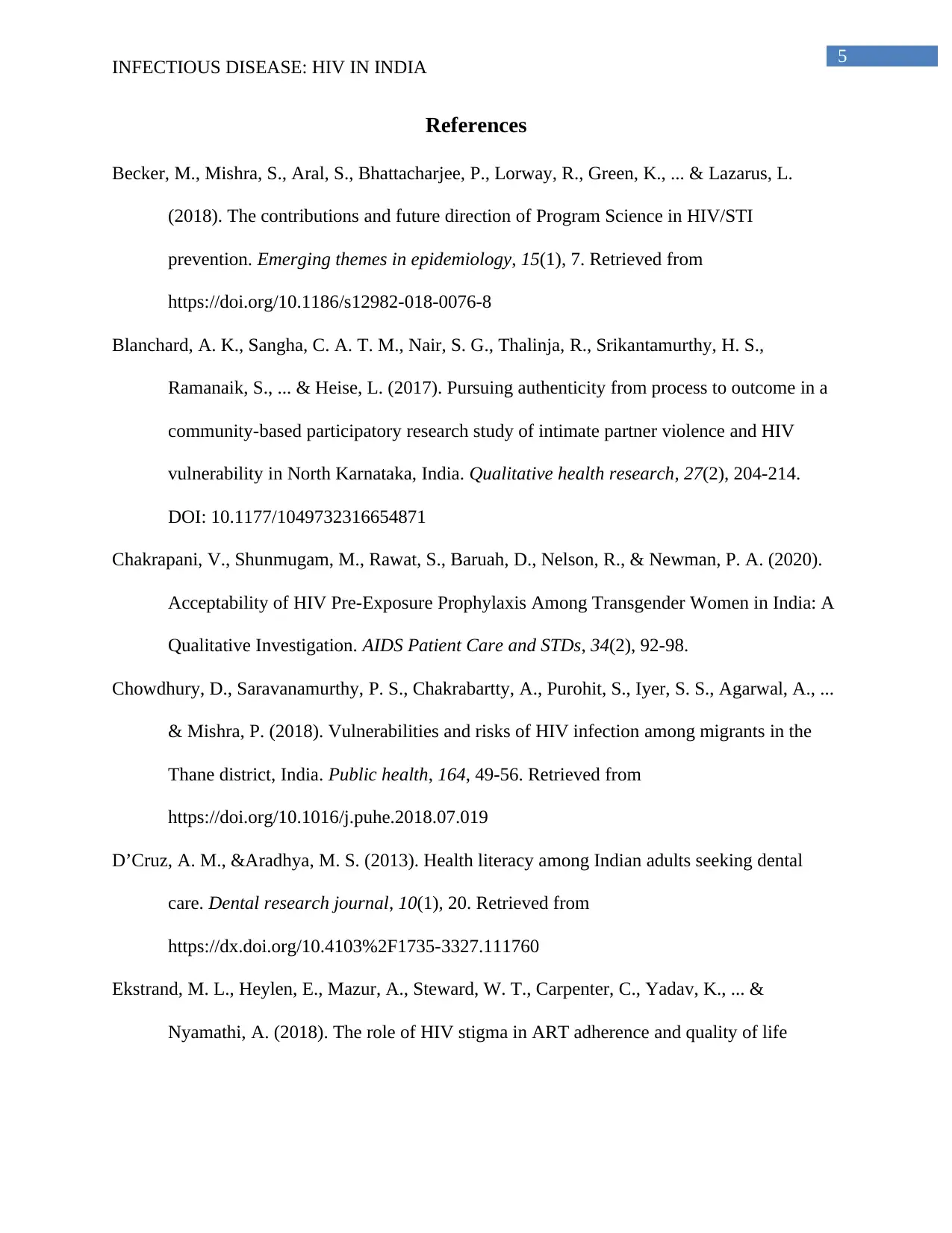
5
INFECTIOUS DISEASE: HIV IN INDIA
References
Becker, M., Mishra, S., Aral, S., Bhattacharjee, P., Lorway, R., Green, K., ... & Lazarus, L.
(2018). The contributions and future direction of Program Science in HIV/STI
prevention. Emerging themes in epidemiology, 15(1), 7. Retrieved from
https://doi.org/10.1186/s12982-018-0076-8
Blanchard, A. K., Sangha, C. A. T. M., Nair, S. G., Thalinja, R., Srikantamurthy, H. S.,
Ramanaik, S., ... & Heise, L. (2017). Pursuing authenticity from process to outcome in a
community-based participatory research study of intimate partner violence and HIV
vulnerability in North Karnataka, India. Qualitative health research, 27(2), 204-214.
DOI: 10.1177/1049732316654871
Chakrapani, V., Shunmugam, M., Rawat, S., Baruah, D., Nelson, R., & Newman, P. A. (2020).
Acceptability of HIV Pre-Exposure Prophylaxis Among Transgender Women in India: A
Qualitative Investigation. AIDS Patient Care and STDs, 34(2), 92-98.
Chowdhury, D., Saravanamurthy, P. S., Chakrabartty, A., Purohit, S., Iyer, S. S., Agarwal, A., ...
& Mishra, P. (2018). Vulnerabilities and risks of HIV infection among migrants in the
Thane district, India. Public health, 164, 49-56. Retrieved from
https://doi.org/10.1016/j.puhe.2018.07.019
D’Cruz, A. M., &Aradhya, M. S. (2013). Health literacy among Indian adults seeking dental
care. Dental research journal, 10(1), 20. Retrieved from
https://dx.doi.org/10.4103%2F1735-3327.111760
Ekstrand, M. L., Heylen, E., Mazur, A., Steward, W. T., Carpenter, C., Yadav, K., ... &
Nyamathi, A. (2018). The role of HIV stigma in ART adherence and quality of life
INFECTIOUS DISEASE: HIV IN INDIA
References
Becker, M., Mishra, S., Aral, S., Bhattacharjee, P., Lorway, R., Green, K., ... & Lazarus, L.
(2018). The contributions and future direction of Program Science in HIV/STI
prevention. Emerging themes in epidemiology, 15(1), 7. Retrieved from
https://doi.org/10.1186/s12982-018-0076-8
Blanchard, A. K., Sangha, C. A. T. M., Nair, S. G., Thalinja, R., Srikantamurthy, H. S.,
Ramanaik, S., ... & Heise, L. (2017). Pursuing authenticity from process to outcome in a
community-based participatory research study of intimate partner violence and HIV
vulnerability in North Karnataka, India. Qualitative health research, 27(2), 204-214.
DOI: 10.1177/1049732316654871
Chakrapani, V., Shunmugam, M., Rawat, S., Baruah, D., Nelson, R., & Newman, P. A. (2020).
Acceptability of HIV Pre-Exposure Prophylaxis Among Transgender Women in India: A
Qualitative Investigation. AIDS Patient Care and STDs, 34(2), 92-98.
Chowdhury, D., Saravanamurthy, P. S., Chakrabartty, A., Purohit, S., Iyer, S. S., Agarwal, A., ...
& Mishra, P. (2018). Vulnerabilities and risks of HIV infection among migrants in the
Thane district, India. Public health, 164, 49-56. Retrieved from
https://doi.org/10.1016/j.puhe.2018.07.019
D’Cruz, A. M., &Aradhya, M. S. (2013). Health literacy among Indian adults seeking dental
care. Dental research journal, 10(1), 20. Retrieved from
https://dx.doi.org/10.4103%2F1735-3327.111760
Ekstrand, M. L., Heylen, E., Mazur, A., Steward, W. T., Carpenter, C., Yadav, K., ... &
Nyamathi, A. (2018). The role of HIV stigma in ART adherence and quality of life
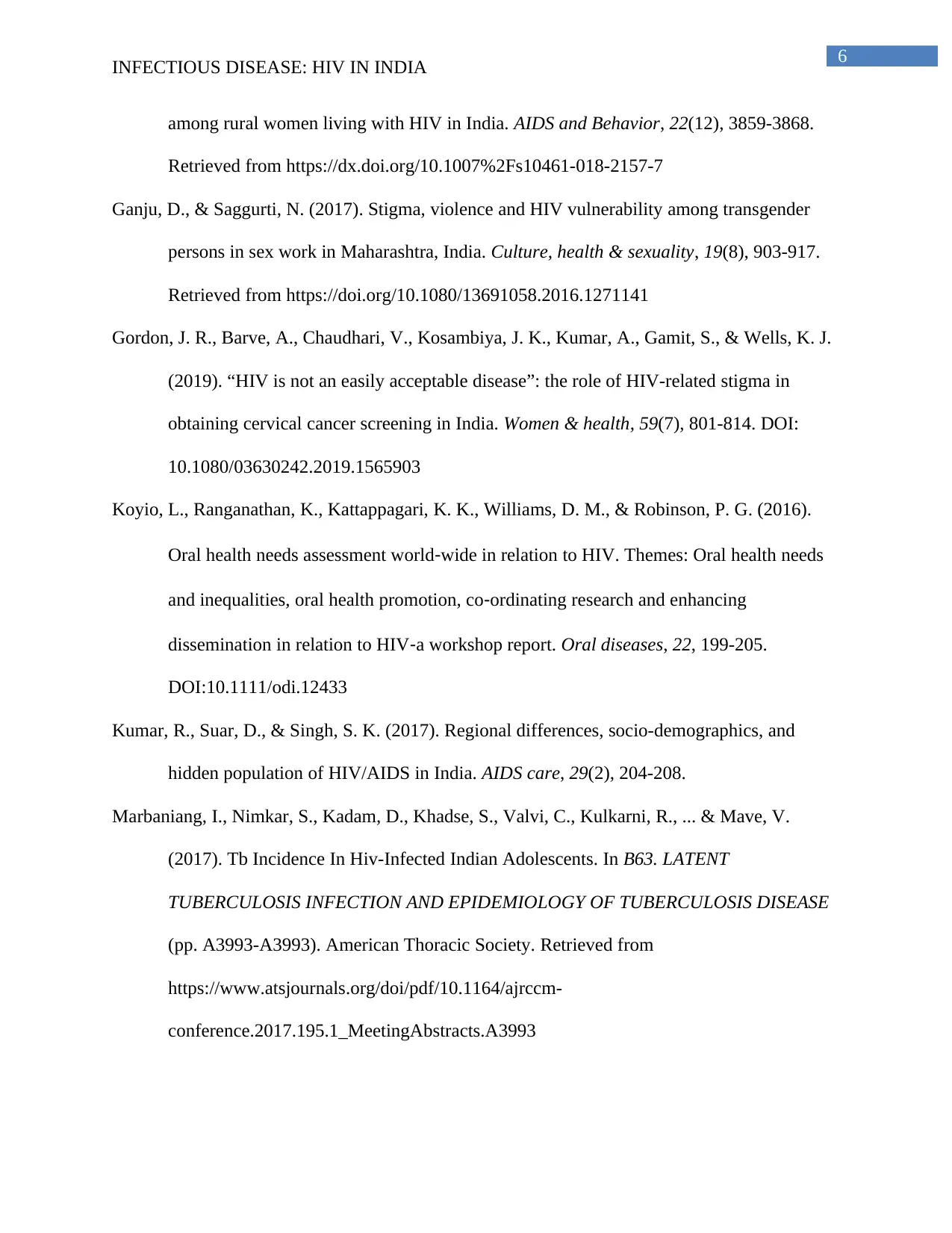
6
INFECTIOUS DISEASE: HIV IN INDIA
among rural women living with HIV in India. AIDS and Behavior, 22(12), 3859-3868.
Retrieved from https://dx.doi.org/10.1007%2Fs10461-018-2157-7
Ganju, D., & Saggurti, N. (2017). Stigma, violence and HIV vulnerability among transgender
persons in sex work in Maharashtra, India. Culture, health & sexuality, 19(8), 903-917.
Retrieved from https://doi.org/10.1080/13691058.2016.1271141
Gordon, J. R., Barve, A., Chaudhari, V., Kosambiya, J. K., Kumar, A., Gamit, S., & Wells, K. J.
(2019). “HIV is not an easily acceptable disease”: the role of HIV-related stigma in
obtaining cervical cancer screening in India. Women & health, 59(7), 801-814. DOI:
10.1080/03630242.2019.1565903
Koyio, L., Ranganathan, K., Kattappagari, K. K., Williams, D. M., & Robinson, P. G. (2016).
Oral health needs assessment world‐wide in relation to HIV. Themes: Oral health needs
and inequalities, oral health promotion, co‐ordinating research and enhancing
dissemination in relation to HIV‐a workshop report. Oral diseases, 22, 199-205.
DOI:10.1111/odi.12433
Kumar, R., Suar, D., & Singh, S. K. (2017). Regional differences, socio-demographics, and
hidden population of HIV/AIDS in India. AIDS care, 29(2), 204-208.
Marbaniang, I., Nimkar, S., Kadam, D., Khadse, S., Valvi, C., Kulkarni, R., ... & Mave, V.
(2017). Tb Incidence In Hiv-Infected Indian Adolescents. In B63. LATENT
TUBERCULOSIS INFECTION AND EPIDEMIOLOGY OF TUBERCULOSIS DISEASE
(pp. A3993-A3993). American Thoracic Society. Retrieved from
https://www.atsjournals.org/doi/pdf/10.1164/ajrccm-
conference.2017.195.1_MeetingAbstracts.A3993
INFECTIOUS DISEASE: HIV IN INDIA
among rural women living with HIV in India. AIDS and Behavior, 22(12), 3859-3868.
Retrieved from https://dx.doi.org/10.1007%2Fs10461-018-2157-7
Ganju, D., & Saggurti, N. (2017). Stigma, violence and HIV vulnerability among transgender
persons in sex work in Maharashtra, India. Culture, health & sexuality, 19(8), 903-917.
Retrieved from https://doi.org/10.1080/13691058.2016.1271141
Gordon, J. R., Barve, A., Chaudhari, V., Kosambiya, J. K., Kumar, A., Gamit, S., & Wells, K. J.
(2019). “HIV is not an easily acceptable disease”: the role of HIV-related stigma in
obtaining cervical cancer screening in India. Women & health, 59(7), 801-814. DOI:
10.1080/03630242.2019.1565903
Koyio, L., Ranganathan, K., Kattappagari, K. K., Williams, D. M., & Robinson, P. G. (2016).
Oral health needs assessment world‐wide in relation to HIV. Themes: Oral health needs
and inequalities, oral health promotion, co‐ordinating research and enhancing
dissemination in relation to HIV‐a workshop report. Oral diseases, 22, 199-205.
DOI:10.1111/odi.12433
Kumar, R., Suar, D., & Singh, S. K. (2017). Regional differences, socio-demographics, and
hidden population of HIV/AIDS in India. AIDS care, 29(2), 204-208.
Marbaniang, I., Nimkar, S., Kadam, D., Khadse, S., Valvi, C., Kulkarni, R., ... & Mave, V.
(2017). Tb Incidence In Hiv-Infected Indian Adolescents. In B63. LATENT
TUBERCULOSIS INFECTION AND EPIDEMIOLOGY OF TUBERCULOSIS DISEASE
(pp. A3993-A3993). American Thoracic Society. Retrieved from
https://www.atsjournals.org/doi/pdf/10.1164/ajrccm-
conference.2017.195.1_MeetingAbstracts.A3993
Paraphrase This Document
Need a fresh take? Get an instant paraphrase of this document with our AI Paraphraser
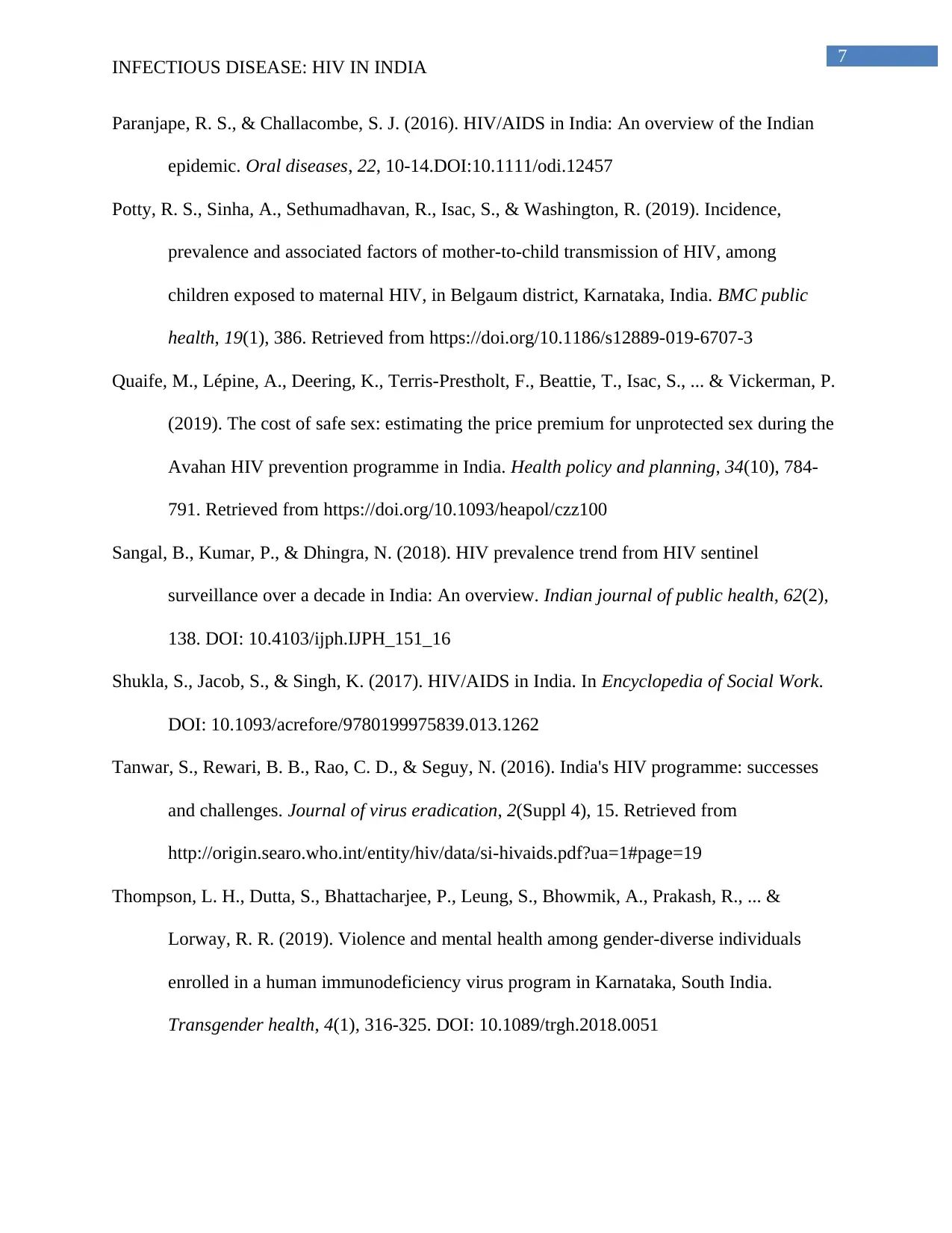
7
INFECTIOUS DISEASE: HIV IN INDIA
Paranjape, R. S., & Challacombe, S. J. (2016). HIV/AIDS in India: An overview of the Indian
epidemic. Oral diseases, 22, 10-14.DOI:10.1111/odi.12457
Potty, R. S., Sinha, A., Sethumadhavan, R., Isac, S., & Washington, R. (2019). Incidence,
prevalence and associated factors of mother-to-child transmission of HIV, among
children exposed to maternal HIV, in Belgaum district, Karnataka, India. BMC public
health, 19(1), 386. Retrieved from https://doi.org/10.1186/s12889-019-6707-3
Quaife, M., Lépine, A., Deering, K., Terris-Prestholt, F., Beattie, T., Isac, S., ... & Vickerman, P.
(2019). The cost of safe sex: estimating the price premium for unprotected sex during the
Avahan HIV prevention programme in India. Health policy and planning, 34(10), 784-
791. Retrieved from https://doi.org/10.1093/heapol/czz100
Sangal, B., Kumar, P., & Dhingra, N. (2018). HIV prevalence trend from HIV sentinel
surveillance over a decade in India: An overview. Indian journal of public health, 62(2),
138. DOI: 10.4103/ijph.IJPH_151_16
Shukla, S., Jacob, S., & Singh, K. (2017). HIV/AIDS in India. In Encyclopedia of Social Work.
DOI: 10.1093/acrefore/9780199975839.013.1262
Tanwar, S., Rewari, B. B., Rao, C. D., & Seguy, N. (2016). India's HIV programme: successes
and challenges. Journal of virus eradication, 2(Suppl 4), 15. Retrieved from
http://origin.searo.who.int/entity/hiv/data/si-hivaids.pdf?ua=1#page=19
Thompson, L. H., Dutta, S., Bhattacharjee, P., Leung, S., Bhowmik, A., Prakash, R., ... &
Lorway, R. R. (2019). Violence and mental health among gender-diverse individuals
enrolled in a human immunodeficiency virus program in Karnataka, South India.
Transgender health, 4(1), 316-325. DOI: 10.1089/trgh.2018.0051
INFECTIOUS DISEASE: HIV IN INDIA
Paranjape, R. S., & Challacombe, S. J. (2016). HIV/AIDS in India: An overview of the Indian
epidemic. Oral diseases, 22, 10-14.DOI:10.1111/odi.12457
Potty, R. S., Sinha, A., Sethumadhavan, R., Isac, S., & Washington, R. (2019). Incidence,
prevalence and associated factors of mother-to-child transmission of HIV, among
children exposed to maternal HIV, in Belgaum district, Karnataka, India. BMC public
health, 19(1), 386. Retrieved from https://doi.org/10.1186/s12889-019-6707-3
Quaife, M., Lépine, A., Deering, K., Terris-Prestholt, F., Beattie, T., Isac, S., ... & Vickerman, P.
(2019). The cost of safe sex: estimating the price premium for unprotected sex during the
Avahan HIV prevention programme in India. Health policy and planning, 34(10), 784-
791. Retrieved from https://doi.org/10.1093/heapol/czz100
Sangal, B., Kumar, P., & Dhingra, N. (2018). HIV prevalence trend from HIV sentinel
surveillance over a decade in India: An overview. Indian journal of public health, 62(2),
138. DOI: 10.4103/ijph.IJPH_151_16
Shukla, S., Jacob, S., & Singh, K. (2017). HIV/AIDS in India. In Encyclopedia of Social Work.
DOI: 10.1093/acrefore/9780199975839.013.1262
Tanwar, S., Rewari, B. B., Rao, C. D., & Seguy, N. (2016). India's HIV programme: successes
and challenges. Journal of virus eradication, 2(Suppl 4), 15. Retrieved from
http://origin.searo.who.int/entity/hiv/data/si-hivaids.pdf?ua=1#page=19
Thompson, L. H., Dutta, S., Bhattacharjee, P., Leung, S., Bhowmik, A., Prakash, R., ... &
Lorway, R. R. (2019). Violence and mental health among gender-diverse individuals
enrolled in a human immunodeficiency virus program in Karnataka, South India.
Transgender health, 4(1), 316-325. DOI: 10.1089/trgh.2018.0051
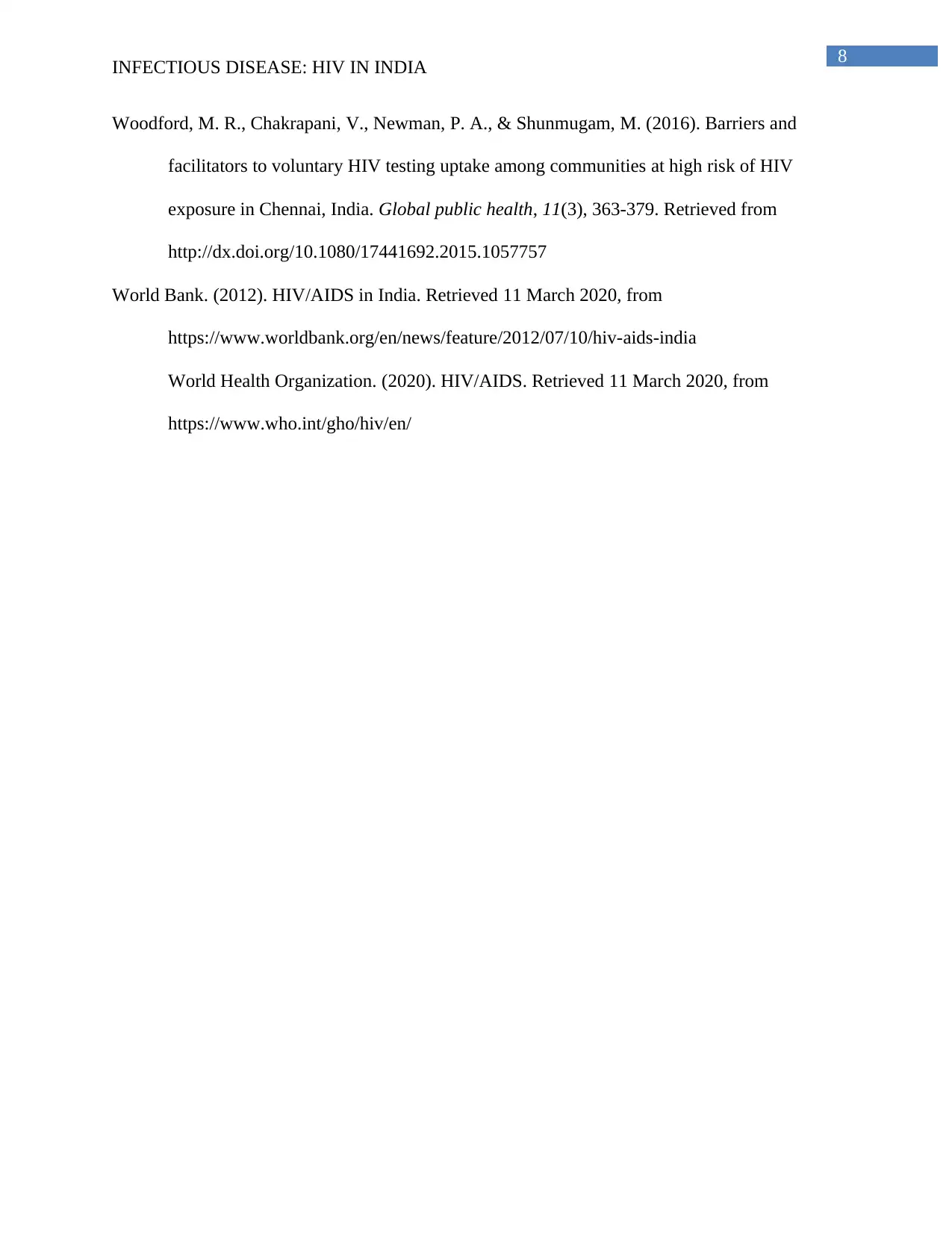
8
INFECTIOUS DISEASE: HIV IN INDIA
Woodford, M. R., Chakrapani, V., Newman, P. A., & Shunmugam, M. (2016). Barriers and
facilitators to voluntary HIV testing uptake among communities at high risk of HIV
exposure in Chennai, India. Global public health, 11(3), 363-379. Retrieved from
http://dx.doi.org/10.1080/17441692.2015.1057757
World Bank. (2012). HIV/AIDS in India. Retrieved 11 March 2020, from
https://www.worldbank.org/en/news/feature/2012/07/10/hiv-aids-india
World Health Organization. (2020). HIV/AIDS. Retrieved 11 March 2020, from
https://www.who.int/gho/hiv/en/
INFECTIOUS DISEASE: HIV IN INDIA
Woodford, M. R., Chakrapani, V., Newman, P. A., & Shunmugam, M. (2016). Barriers and
facilitators to voluntary HIV testing uptake among communities at high risk of HIV
exposure in Chennai, India. Global public health, 11(3), 363-379. Retrieved from
http://dx.doi.org/10.1080/17441692.2015.1057757
World Bank. (2012). HIV/AIDS in India. Retrieved 11 March 2020, from
https://www.worldbank.org/en/news/feature/2012/07/10/hiv-aids-india
World Health Organization. (2020). HIV/AIDS. Retrieved 11 March 2020, from
https://www.who.int/gho/hiv/en/

9
INFECTIOUS DISEASE: HIV IN INDIA
INFECTIOUS DISEASE: HIV IN INDIA
1 out of 10
Related Documents
Your All-in-One AI-Powered Toolkit for Academic Success.
+13062052269
info@desklib.com
Available 24*7 on WhatsApp / Email
![[object Object]](/_next/static/media/star-bottom.7253800d.svg)
Unlock your academic potential
© 2024 | Zucol Services PVT LTD | All rights reserved.





